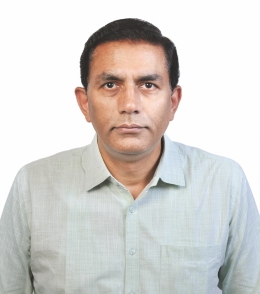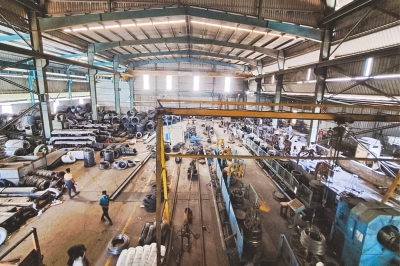Fortran Steel Private Limited was conceived in 1991 to manufacture a wide array of hot rolled and structural steel products. The company’s wire plant produces hard bright wire, HHB wire, annealed wires, galvanized wires, alloy steel wires, MS flat wires and others. Whereas, the company’s rolling mills produce round bars, flat bars, bright bars, bright bars, all produced in MS and stainless steel. In a recent conversation with Wire & Cable India, Mr. Jatin Parekh, CEO, Fortran Steel Private Limited, shared about his company’s business journey, recent developments, USP, product portfolio and shared his thoughts on the challenges in the Indian and global steel wire industry, and how to overcome them.
Wire & Cable India: Could you please take us through the business journey, milestones and achievements of your company?
Jatin Parekh: Since its establishment 30 years ago, Fortran Steel has continuously evolved as a steel company, and is a regular supplier to some of the top companies in India and to over 23 countries like the Gulf countries, Africa, South America, Europe and others. Initially, Fortran manufactured steel rounds, flat bars and wires of commercial and general engineering grades. Today, the company also manufactures stainless steel bright bars and special grades of wires especially in alloy steel, high carbon steel, spring steel, and others.
WCI: Brief us about your specialized products along with their USPs.
JP: The products manufactured at our wire plant include hard bright wire, HHB wire, annealed wires, galvanized wires, alloy steel wires, MS flat wires, wire nails, CO2 wires and stainless steel wires. Our rolling mills produce round bars, flat bars, bright bars, bright bars, all produced in MS and stainless steel. Our USPs include catering to the OEM sector with a special thrust on the niche market, competitive price, timely delivery, effective redressal of quality complaints and timely delivery of invoice along with the material test certificate.
“ The size of the steel wire industry in India is approximately 3.2 million tonnes in terms of volume, and USD 2.1 billion in terms of value, combining both organized and unorganized sectors. Approximately 75 percent of total production comes from organized producers and the rest from the unorganized counterpart. ”
WCI: What have been the recent developments at your organization and what are your future growth plans?
JP: Recently, Fortran has been focusing on strengthening the sales team, and we have been appointing product-wise sales managers with our team of sales coordinators. We are also gradually moving towards a more system-oriented process, where we focus on development of new OEM and their vendor registration. Fortran is also putting more impetus towards the growth of export and induction of OEM customers for value added grade, working towards chemical free processes, inline grinding and shot blasting.
In terms of our future plans, we aim to increase our existing plant’s capacity to 100 percent by 2025, along with implementing forward and backward integration to enhance the production capacity of the plant further. We will purchase machines for straight line wire production and grinding machines. Fortran is also aiming to set up a stainless steel plant for billets and rounds. We also aim to set up a digital marketing team for online marketing, and increase production by means of additional equipment and enriching product mix.
Watch: RR Kabel | Solar Cables | Solar Plant | Renewable Energy
WCI: Share with us about your major projects and clientele you are catering to.
JP: The major projects we have been involved in are the Nagpur metro rail project, Samruddhi Mahamarg highway project, Mumbai Trans- Harbour sea link, Mumbai-Delhi corridor and the Bullet Train project. We provide wires to the fastener, railways and infrastructure industries; special steel to the automobile, railways, infrastructure, barbed wire, fastener and wire mesh industries; fasteners and bright bars to the vendors of automobile, shipping and railways industries; and fan guards to the railways coaches.
WCI: Describe your manufacturing setup for the steel wire sector.
JP: Our wire plant comprises a wire drawing unit with a 1.50mm to 13mm range, an annealing furnace, a coating or plating section, cutting and spooling units and a quality control laboratory. The specific capabilities and equipment of a wire plant can vary depending on the type of wire being produced for particular applications.
WCI: Please share your views on the Indian vis a vis the global steel wire industry. What is the role of the Indian government in the growth of this sector?
JP: The size of the steel wire industry in India is approximately 3.2 million tonnes in terms of volume, and USD 2.1 billion in terms of value, combining both organized and unorganized sectors. Approximately 75 percent of total production comes from organized producers and the rest from the unorganized counterpart. India constitutes 1.3 per cent of the global wire exports and approximately 3.2 percent of Indian production caters a portion of the global markets.
The fortunes of the steel wire industry are closely linked to the fortunes of the primary steel industry. Internationally steelmakers prospects to 2023 are mixed, due to consolidations in most parts of the old industrial world; a resurgence of steelmaking capacity addition in the Far East (particularly in India), in Latin America (Brazil), Vietnam, Indonesia and in the Middle East; a revitalization of the Russian steel industry and continued massive expansion in China. One factor stimulating new capacity is the technological revolution which is sweeping the industry. The Indian government is taking multiple steps to play their role in the growth of this sector. The government has applied anti-dumping duties on high carbon, alloy steel and stainless steel wires because of dumping from countries like China, Vietnam, Indonesia, Turkey, among others. The government is also building pressure to make allocation of special steel wire rods like high carbon, alloy steel and spring steel regularly from the primary producer. Furthermore, the government is providing incentives to put up steel wire plants in rural and semi-rural areas, providing export incentives for export of high carbon, alloy steel and spring steel wires, as well as reducing power tariffs for industries to make them a viable unit.
Also Read: Polycab India: “Industry is Well- Prepared to Meet Technological Advancements of Tomorrow”
WCI: What are the major ongoing challenges in the Indian steel wire industry?
JP: Significant investments are needed to set up modern steel wire plants with new technology adoption. Some challenges are low per capita consumption of steel wire, cheap import of wires from China, Vietnam, Indonesia, Turkey etc., interrupted power supply for steel wire production, dependence on costly coal imports resulting in higher steel prices, frequent change in raw material prices, and logistics and transportation problems.
WCI: How can these challenges of the industry be addressed? How is your company contributing towards this transition?
JP: The industry challenges can be addressed through various ways. The government can take initiative through financial institutions and receive bank support for easy and flexible financing. This can be done by approaching banks and financial institutions for lower interest financing for the MSME sector as well as getting in touch with foreign banks. The government should also advocate the idea of using more steel wire, both galvanized and stainless steel, in infrastructure, steel and concrete buildings, through technical presentation, literature, experts professional, exhibition, trade fair etc. It is also imperative that the government fix import prices for the wires and discourage usage of imported wire by way of making easy availability of the right type of wire quality domestically, to procure maximum from the domestic source by means of monthly and quarterly contract.
To ensure uninterrupted power supply from the government and private power plants, we must put up a solar plant to ensure uninterrupted power supply to our unit. We must also explore areas for coking coal mines and get the right quality of coking coal from the domestic source by reducing ash content through coal washeries. Government should also intervene to curb the logistics cost by standardizing freight charge on a per kilometer basis, as well as further enhance highway development. We must increase our transporter base so that through the way of tender, a minimum logistic price is arrived at. The steel wire industry is in a dynamic environment, therefore to keep a tab on the market dynamics and accordingly decide the short term strategy.






